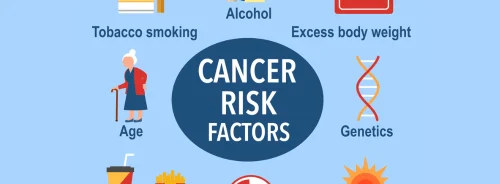In recent years, a significant proportion of cancer cases and deaths in the United States have been linked to potentially modifiable risk factors. In 2014, it was estimated that approximately 42% of incident cancer cases and 45% of cancer deaths were attributable to these risk factors. More precise information has become available with advancements in data collection and analysis, especially concerning physical inactivity and carcinogenic infections. A recent article published in CA: A Cancer Journal for Clinicians delves into contemporary estimates of cancer incidence and mortality attributable to modifiable risk factors in 2019, providing valuable insights for cancer control initiatives. Understanding these factors and their impact is crucial for implementing effective public health strategies and reducing the overall burden of cancer in the population.
Cigarette Smoking and Cancer
Cigarette smoking remains the leading contributor to cancer cases and deaths in the United States. The analysis indicates that cigarette smoking was responsible for 19.3% of all cancer cases in 2019, accounting for 344,070 cases. The burden of smoking-related cancer was higher in men (22.7%) than in women (15.8%). Lung cancer had the most significant number of smoking-attributable cases, with 85.6% of lung cancer cases linked to smoking. Cancers of the trachea, larynx, pharynx, oral cavity, nasal cavity, oesophagus, and urinary bladder followed this. In addition to direct smoking, second-hand smoke contributed an additional 2.7% of lung cancer cases.
The prevalence of cigarette smoking has declined dramatically over the past few decades due to comprehensive tobacco control programmes. However, further efforts are necessary to continue this downward trend. Increasing cigarette taxes is one of the most effective measures to reduce smoking rates. For example, the US Surgeon General has suggested raising the average retail price of cigarettes to at least $10 a pack. In 2019, the average price varied significantly across states, from $5.21 in Missouri to $10.53 in New York. Strengthening smoke-free laws, providing assistance with smoking cessation, implementing warning labels and media campaigns, and banning tobacco marketing are other effective strategies. Despite these efforts, there is a need for continued political commitment at local, state, and federal levels to further reduce smoking prevalence and the associated cancer burden.
Support for smoking cessation is crucial, especially for younger individuals, as quitting smoking is associated with a substantial reduction in cancer mortality risk. Unfortunately, smoking cessation services, such as counselling and medication, are underused, particularly among individuals with lower incomes and those who are uninsured. Enhancing equitable access to cessation services is essential. Additionally, lung cancer screening among high-risk individuals remains low, with less than 7% of eligible individuals receiving recommended screenings nationally in 2019 and 2021. Improving screening rates can help detect lung cancer at earlier, more treatable stages, further reducing mortality.
The Impact of Excess Body Weight, Alcohol Consumption, and Physical Inactivity
Excess body weight, alcohol consumption, and physical inactivity are significant contributors to cancer incidence. In 2019, excess body weight accounted for 7.6% of all cancer cases, with higher proportions in women (10.6%) compared to men (4.8%). Cancers of the corpus uteri, gallbladder, oesophagus, liver, and kidney were notably associated with excess body weight. Obesity is a growing epidemic in the United States, affecting 42% of adults aged 20 years and older. The prevalence of obesity and severe obesity has substantially increased over the past few decades, highlighting the need for effective interventions.
Alcohol consumption contributed to 5.4% of all cancer cases, with notable differences between men (4.7%) and women (6.2%). Alcohol-related cancers include those of the oral cavity, pharynx, oesophagus, liver, and breast. Female breast cancer had the most significant number of alcohol-attributable cases, followed by colorectal cancer in both men and women. Reducing alcohol consumption through public health strategies, such as increasing alcohol taxes, restricting alcohol availability, and providing counselling interventions, can help mitigate this risk.
Physical inactivity was responsible for 3.1% of cancer cases, with higher contributions in women (4.4%) compared to men (1.8%). Cancers of the stomach, female breast, and colon were most affected by physical inactivity. Promoting physical activity through improving the built environment, enhancing access to places for physical activity, and implementing school and workplace programmes can help reduce the burden of cancer-related to inactivity.
Maintaining a healthy body weight, limiting alcohol consumption, consuming a healthy diet, and being physically active can substantially reduce the number of cancer cases and deaths in the United States. This conclusion is consistent with several previous studies that have shown a reduced risk of developing and dying from cancer in individuals who adhere to comprehensive guidelines on weight, nutrition, and physical activity, including those of the American Cancer Society.
Dietary Factors and Carcinogenic Infections
Dietary factors, including low consumption of fruits and vegetables, dietary fibre, and calcium, were linked to 4.9% of all cancer cases. Among dietary factors, low fruit and vegetable consumption had the most significant impact, particularly on cancers of the oral cavity, pharynx, oesophagus, and larynx. The prevalence of inadequate dietary intake remains high, with only 12% of individuals aged 18 years and older meeting recommended vegetable and fruit consumption in 2021.
Carcinogenic infections, such as those caused by HPV, HCV, and H. pylori, accounted for 3.4% of cancer cases. HPV was the leading infectious contributor, particularly affecting cervical, anal, and oropharyngeal cancers. Despite the availability of HPV vaccination, the uptake remains suboptimal, with only 64% of girls aged 13-17 years up-to-date with vaccination in 2021. Increasing vaccination coverage is essential to reduce the burden of HPV-related cancers.
HCV infection had the second largest PAF among carcinogenic infections in men (about 1%). The prevalence of chronic HCV infection has increased, particularly among individuals born during 1945-1965. Acute HCV infection rates have also risen in younger adults due to the opioid epidemic, which can lead to increases in chronic HCV infections and liver cancer incidence in the future. Early detection and treatment of HCV infection are crucial, as effective oral direct-acting antivirals can reduce the risk of HCV-related liver cancer. However, screening and access to high-cost anti-HCV medications remain suboptimal, particularly among uninsured individuals who bear a disproportionately high burden of HCV infection.
H. pylori infection contributed to about 1% of all cancer cases and deaths, primarily affecting gastric cancer. The prevalence of H. pylori infection has decreased due to improvements in sanitation and antibiotic use. Current guidelines recommend screening for H. pylori in individuals with certain conditions, such as peptic ulcer disease or a history of early gastric cancer, and providing treatment for those who test positive.
The findings from this 2019 analysis highlight that 40% of all cancer cases and nearly half of all cancer deaths in the United States are attributable to potentially modifiable risk factors. Cigarette smoking, excess body weight, alcohol consumption, physical inactivity, dietary factors, and carcinogenic infections are significant contributors to the cancer burden. Comprehensive public health strategies focusing on tobacco control, promoting healthy lifestyles, and infection prevention can substantially reduce cancer incidence and mortality. Effective interventions include increasing cigarette taxes, enhancing access to smoking cessation services, promoting healthy diets and physical activity, reducing alcohol consumption, and improving vaccination and infection screening programmes.
Continued research and implementation of effective interventions are essential to mitigate these risk factors and improve cancer outcomes in the United States. Tailored and mutually reinforcing interventions are more likely to be effective, especially in historically marginalised populations that are usually disproportionately affected by these factors. Further research is needed on the association between potentially modifiable risk factors and cancers for which the current evidence for causality is limited, as well as on common cancers with few established modifiable risk factors. Additionally, investigating the impact of other potentially modifiable exposures, such as occupational carcinogens, air pollution, and other environmental risk factors, as well as the interactions between risk factors, will provide a more comprehensive understanding of cancer prevention. By addressing these modifiable risk factors through targeted public health initiatives, we can make significant strides in reducing the burden of cancer and improving the population's overall health.
Source: CA: A Cancer Journal for Clinicians
Image Credit: iStock






